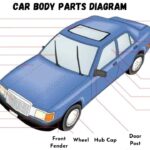When it comes to vehicle stability and handling, especially when navigating turns, the Sway Bar Car Part plays a pivotal role. Often understated, this component is crucial for ensuring a smooth, safe, and controlled driving experience. If you’ve ever wondered what keeps your car from leaning excessively in corners, the sway bar is a key player. In this guide, we’ll delve into the function, importance, and symptoms of a failing sway bar, providing you with expert knowledge to understand this essential suspension component.
Understanding the Sway Bar: Function and Mechanics
The primary function of a sway bar, also known as an anti-roll bar or stabilizer bar, is to minimize body roll in a vehicle. Body roll, or body lean, is the tilting of a vehicle’s body towards the outside of a turn due to centrifugal forces. This is particularly noticeable in larger vehicles like SUVs, trucks, and RVs, but it affects all vehicles to some extent.
Imagine your vehicle making a turn. The weight of the vehicle naturally shifts outwards, towards the outside wheels. Without a sway bar, this weight transfer would cause the outside suspension to compress and the inside suspension to extend, leading to significant body lean. This can feel unsettling, reduce tire contact with the road, and even pose a safety risk.
This is where the sway bar steps in. Essentially a torsion spring, the sway bar connects the left and right wheels of a vehicle together through the suspension system. When your vehicle corners, and one wheel rises or falls relative to the other, the sway bar twists. This twisting motion resists the difference in suspension compression between the two sides of the vehicle.
Alt text: Diagram illustrating a sway bar connecting the suspension components of a vehicle to reduce body roll during cornering.
To elaborate, when the body of the vehicle starts to roll during a turn, the sway bar experiences a torsional force. One end of the sway bar, connected to the outside wheel’s suspension, is forced upwards (in relative terms), while the other end, connected to the inside wheel’s suspension, is forced downwards. This difference in vertical movement causes the sway bar to twist. As a torsion spring, it resists this twist, effectively transferring some of the force from the heavily loaded outside suspension to the lightly loaded inside suspension. This action helps to level the vehicle, keeping the tires more evenly planted on the road.
It’s important to note that sway bars are most effective when the suspension on each side of the vehicle is moving differently, such as during cornering or uneven road surfaces. If both wheels encounter bumps or dips simultaneously, the sway bar experiences minimal twisting force and has less effect on the suspension movement.
Why Sway Bars are Crucial for Vehicle Performance and Safety
The benefits of a properly functioning sway bar car part extend far beyond just a comfortable ride. They are integral to vehicle safety, handling, and even tire longevity. Here’s a breakdown of why sway bars are so important:
- Enhanced Safety: By significantly reducing body roll, sway bars help to keep the vehicle more stable during maneuvers. Excessive body roll can lead to a higher risk of rollover, especially in taller vehicles. A sway bar mitigates this risk, contributing to safer driving, particularly in emergency situations or sharp turns.
- Improved Handling and Control: Sway bars contribute to more predictable and responsive handling. By limiting body roll, they ensure that your tires maintain better contact with the road surface. This increased contact patch translates to better grip, allowing for sharper turns, improved steering response, and overall enhanced vehicle control.
- Prevention of Uneven Tire Wear: Excessive body roll can lead to uneven weight distribution across the tires, causing some tires to bear more load than others during cornering. This uneven loading can result in premature and uneven tire wear. By distributing weight more evenly across all four tires during turns, sway bars help to prolong tire life and ensure more even wear patterns.
- Increased Passenger Comfort: While safety and performance are paramount, passenger comfort is also a significant benefit. Reduced body roll translates to a smoother and more comfortable ride, especially for passengers who are prone to motion sickness. Less leaning and swaying makes for a more pleasant driving experience for everyone in the vehicle.
Alt text: Close-up view of sway bar components including the bar itself, bushings, and end links, highlighting their connection to the vehicle’s suspension.
Recognizing the Symptoms of a Failing Sway Bar
Like any car part, the sway bar car part and its associated components can wear out or become damaged over time. Recognizing the symptoms of a failing sway bar is crucial for timely repair and maintaining vehicle safety and handling. Here are common signs to watch out for:
- Rattling or Clunking Noises: One of the most noticeable symptoms of a failing sway bar or its components (like sway bar links or bushings) is unusual noises coming from the suspension area. These noises are often described as rattling, clunking, or banging sounds, particularly when driving over bumps, potholes, or uneven road surfaces, or when turning at lower speeds.
- Excessive Body Roll: If you notice your vehicle leaning more than usual during turns, this could be a sign of a sway bar issue. While some body roll is normal, a significant increase indicates that the sway bar is not effectively resisting the weight transfer. This can feel like the car is “wallowing” or unstable in corners.
- Poor Handling and Steering Response: A damaged or disconnected sway bar can negatively impact your vehicle’s handling. You might experience vague or unresponsive steering, making it harder to control the vehicle in turns. The vehicle may feel less stable and more prone to swaying from side to side, particularly at higher speeds or in windy conditions.
- Loose or Vague Steering Feel: In some cases, a failing sway bar component can contribute to a loose or vague feeling in the steering wheel. This can make it harder to maintain a straight line and require more steering input to keep the vehicle on course.
- Visual Inspection of Sway Bar Components: A visual inspection can often reveal problems. Check the sway bar itself for any signs of damage, such as cracks or bends. More commonly, the sway bar links and bushings wear out. Look for broken or detached sway bar links, and check the bushings for wear, cracking, or excessive play. Bushings are typically made of rubber or polyurethane and are designed to cushion the sway bar and allow for movement, but they degrade over time.
If you experience any of these symptoms, it’s advisable to have your vehicle inspected by a qualified mechanic. Addressing sway bar issues promptly is important for maintaining vehicle safety and preventing further damage to the suspension system.
Sway Bars in Different Vehicle Types
While the fundamental function of a sway bar car part remains consistent across different vehicle types, their importance can vary depending on the vehicle’s size, weight, and intended use.
- Passenger Cars and Sedans: Sway bars are standard equipment in most passenger cars and sedans. They are tuned to provide a balance between comfortable ride quality and adequate handling for everyday driving.
- SUVs and Trucks: Due to their higher center of gravity and increased weight, SUVs and trucks are more prone to body roll. Sway bars are particularly crucial in these vehicles to maintain stability and control, especially when carrying loads or navigating off-road terrain. Often, SUVs and trucks will have larger and more robust sway bars than smaller passenger cars.
- RVs and Motorhomes: RVs and motorhomes, being exceptionally large and heavy, are highly susceptible to body roll, especially in windy conditions or during turns. Sway bars are essential for these vehicles, not only for safety but also for driver comfort. Without effective sway bars, driving a large RV can be tiring and even dangerous due to excessive swaying and instability. Upgraded or heavy-duty sway bars are often recommended for RVs to enhance stability and reduce driver fatigue.
In conclusion, the sway bar car part is a seemingly simple component that plays a critical role in vehicle dynamics, safety, and comfort. Understanding its function and recognizing the symptoms of a failing sway bar can empower you to maintain your vehicle effectively and ensure a safer and more enjoyable driving experience. If you suspect an issue with your sway bar, don’t hesitate to consult with a professional mechanic for inspection and repair.

